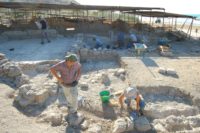 An international team of archaeologists, students and volunteers excavating the Roman villa of Durreueli at Realmonte in Sicily have unearthed evidence of habitation and usage from a much broader period than previously realized.
An international team of archaeologists, students and volunteers excavating the Roman villa of Durreueli at Realmonte in Sicily have unearthed evidence of habitation and usage from a much broader period than previously realized.
Through a month of excavations, they determined the villa was consistently occupied between the 2nd and 7th century CE and reconfigured to settlement in the 5th century Common Era (CE). That conclusion comes following the discovery of new walls, floor levels, staircase and water channel.
The team found cookware and lamps along with a large quantity of African Late Roman pottery and related materials such as kiln spacers. This leads researchers to believe an important function of the village was to produce pottery, bricks and tiles in industrial scale, helping explain the economic history of Late Antique Sicily.
One of Sicily’s largest Roman villas covering 5,000 square meters (54,000 square feet) in area, the Durreueli remains were first discovered in the early 1900s during railroad construction. They weren’t professionally excavated until 1979 when a team of Japanese archaeologists explored the site for six years. They unearthed important parts of the villa, including its baths and exceptional mosaics dedicated to the deities of the sea the structure so dramatically overlooks, but nowhere near the wide range of dates that the current excavation has encountered.
After Japanese excavation ended in 1985, the site was closed the public and all but ignored, even though it is just a hop, skip and a jump from the area’s preeminent tourist attraction, the Scala dei Turchi (the staircase of the Turks), a limestone rock formation that looks like gigantic steps built on a golden beach. The city of Agrigento with its exceptional Doric temple is just six miles to the east.
Dig director Dr. Davide Tanasi, assistant professor in History at the University of South Florida, sought to rectify this unfortunate neglect of such significant archaeological remains. Working with the Superintendence for Cultural Heritage of Agrigento, Tanasi not only excavated the villa this season, making important finds that vastly expanded its chronology, he enlisted USF’s state-of-the-art Center for Virtualization and Applied Spatial Technologies (CVAST) to thoroughly scan the site and create 3D views that will prove invaluable in determining the best approach to ongoing excavations in interpreting the phases of construction.
There aren’t any really good pictures of the excavation (not by my standards anyway), but Dr. Tanasi’s YouTube channel steps into the breach. There are super-short videos of the excavators in action:
Charming testimonials from participants in the project:
And the greatest gems in the collection, aerial and terrestrial 3D scans of the whole villa which are extremely cool views for we civilians as well as and essential tools for archaeologists.
The USF team will return to the villa next summer for a second season of excavations.
Was there any articular reason, oh blogger, for prohibiting comments on the daguerreotype portrait of John Quincy Adams? I mean, comments would have let us all practise our spelling of Daggerrotipe.
Hail and praise to beach archeology ! 😎 – Even if the ‘Common Era’ feels rather uncommon.
Elsewhere, I unearthed an amphora base myself: It had been punching my spine underneath my beach towel. There was a vertebra cut in half and another bone, which lead to belief that I was dealing with BBQ leftovers
(holiday resort for 2000+ years, once there was a harbor – and plenty of BBQs).
I much prefer BC and AD.
I presume no-one here needs an explanation of the terms?
I always pronounce CE as Christian Era. It’s so much less patronising towards members of non-Christian cultures to eschew pretending that there was anything “Common” about the era.
This is outstanding and great post! i really like it. Thank you so much.
This is outstanding and great post!
Thanks For Share This information if you want Toshiba Laptop support USA then click here: